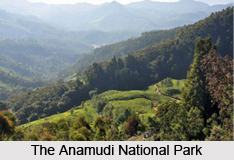 Anamudi Shola National Park is situated along the Western Ghats in the Idukki district of Kerala, India. More specifically, it is a part of Marayoor village in Devikulam Taluk, located in Idukki district. Draft notification of this new park was released on November 21, 2003. This area is under protection and is administered by the Kerala Department of Forests and Wildlife, Munnar Wildlife Division. It is composed of Idivara Shola Reserve, Pullardi Shola Reserve and Mannavan Shola Reserve. Characteristically, this park is a rain forest. This national park is a part of the Anamalai sub-cluster, which was recently nominated for consideration for World Heritage Site status, under UNESCO`s (United Nations Educational, Scientific and Cultural Organization) World Heritage Programme.
Anamudi Shola National Park is situated along the Western Ghats in the Idukki district of Kerala, India. More specifically, it is a part of Marayoor village in Devikulam Taluk, located in Idukki district. Draft notification of this new park was released on November 21, 2003. This area is under protection and is administered by the Kerala Department of Forests and Wildlife, Munnar Wildlife Division. It is composed of Idivara Shola Reserve, Pullardi Shola Reserve and Mannavan Shola Reserve. Characteristically, this park is a rain forest. This national park is a part of the Anamalai sub-cluster, which was recently nominated for consideration for World Heritage Site status, under UNESCO`s (United Nations Educational, Scientific and Cultural Organization) World Heritage Programme.
Geography of Anamudi National Park
Globally, this park can be pinpointed between 10 degrees 10 minutes to 10 degrees 12 minutes and 18 seconds north latitude and 77degrees 09minutes 50 seconds to 77 degrees 12 minutes and 18 seconds east longitude. As per the Survey of India Toposheet, the actual area covered by this park is about 42.68 square kilometers, although its notified extent is 7.5 square kilometers. Its elevation ranges from 2,152 meters (7,060 ft) to 2,305 meters (7,562 ft). The climate is cool during most of the year with the temperature ranging between 9.5 degrees in December to 30 degrees in April. This park is blessed with very high rainfall. This area receives an annual average rainfall of about 4,500 millimeters (180 in). It is well connected with and surrounded by other wildlife parks and sanctuaries, like the Mathikettan Shola National Park, Eravikulam National Park, Pambadum Shola National Park, Chinnar Wildlife Sanctuary and the Kurinjimala Sanctuary. The shola forest gracing this park forms the catchment of the east flowing river named Pambar. Also, many perennial streams originate from this forest. The river Pambar flows eastwards through the sanctuary and forms a waterfall called the Thoovanan Waterfall. This waterfall on the river Chinnar is a silvery cascade, which is known to allure visitors. Guided trekking from Karimutti Forest Station can take one to Thoovanam waterfalls. Tea plantations are also situated close to this park. Muthuvan is the only tribe known to reside in this sanctuary.
Flora and Fauna of Anamudi National Park
The Anamudi National Park is a home to about 62 species of trees, about 174 species of herbs and shrubs and about 39 species of climbers. One of the largest shola forest eco-system in India is found in this park. This forest maintains a unique biodiversity and climate. This park is beautified with west coast tropical evergreen forest. Southern hilltop tropical vegetation is also found in higher altitudes. The bark of the trees in this park is covered with lichens, mosses and climbers.
The Anamudi Shola National Park is also diverse in terms of wildlife. This park preserves about 100 species of butterflies, about 232 species of moths and near about 76 species of birds. Some of the animals housed in this park are panther, Indian bison, Nilgiri tahr, wild elephant and tiger. Some other mammals commonly found in this park are- wild boar, leopards, wolves, gaur, spotted deer, squirrel and jungle cat.
It is important to note that many species in this park are endemic and some of them are threatened. For example, parantica nilgiriensis is a RET listed species of butterfly, preserved in this park.
Visiting Information
October to March is generally considered to be the best season to visit this park. This park can be reached from Kochi, which is at a distance of about 160 km. Coimbatore is also situated at a reasonable distance of about 150 km from the park. The nearest railway station is at Aluva (150 km) in Kerala and Pollachi (100 km) in Tamil Nadu. This park is about 45 km from Munnar, which is the nearest town from the park. This park is accessible by road from Marayoor.
Related Articles:
Indian National Parks
Periyar Tiger Reserve, Kerala
Silent Valley National Park
Mathikettan Shola National Park
Parambikulam Wildlife Sanctuary
Indian Wildlife











